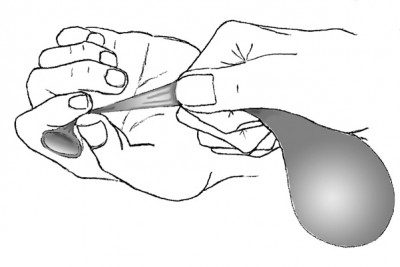A No-tech Tool for Teaching
Weekly Teaching Tip – Sep. 28, 2015
by Mark Baxter
In this age of digital this and virtual that it can be overwhelming to find good teaching aids to help you demonstrate healthy singing behaviors. Some of the new software and apps are great, but when I want to make a lasting impression on either a large group or a single singer my favorite visual aid is the same one I’ve used for over thirty years: a balloon. Yup – a pearl-white nine inch party balloon. Nope – I don’t make animals with them!
White, because that’s the color of healthy vocal folds. I use the “nine inch” size because its neck best represents the average size of adult vocal folds.
I inflate the balloon and ask, “What do I have to do to make the air come out?” When the student says, “just let go,” I do – and the balloon flies around the room and bellows a big fart noise. That gets their attention and allows me to talk about the role of atmospheric air pressure in breath management. It’s especially good for chronic hyper-function singers to ponder this: “A balloon doesn’t have any muscles, so what makes the air come out with such force?” Then I explain that their lungs are made of 600 million tiny balloons (alveoli) and that the onset of singing is best thought of as a controlled release.
To simulate a controlled release I re-inflate the balloon and use my fingers to create a slit in its neck for the air to pass through as shown in the figure below. The balloon sings! This is a great representation of the vocal folds in action. Just by manipulating the opening with your fingers you can change pitch, create vibrato and even emulate a raspy sound – all on a controlled release of atmospheric air pressure.
Then I give the student the balloon and have him or her isolate a section of the balloon’s neck as shown in the second illustration. For female students the section between the thumbs should be ½ inch (12.7 mm) and for males ¾ of an inch (19 mm). Have the student sing a simple scale while they stretch the balloon to mimic the influence of the cricothyroid muscle (CT) on the folds. (Stretch as the pitches rise and relax the tension as the pitches descend) This allows them to visualize the horizontal mechanism of pitch (often imagined as vertical). If you want to discuss the thyroaryteniod muscle (TA) just double or triple the balloon to thicken the mass. Once the student coordinates the balloon with their voice you’ll notice how big the movements are for each step of the scale. This let’s you literally “see” what’s going on in their mind. Oh my!
Stubborn vocal issues are the result of faulty mental concepts. To bring the student’s image of their voice in line with reality, ask them to reduce the stretch of the balloon between their hands by half and sing again. The motion will still be too big. Have them reduce the movement again. And again. Keep asking until the stretch motion is barely visible. Watch their eyes widen as you then explain that that tiny little movement is what’s actually occurring inside their larynx as they sing. Better yet, watch years of hyper-function melt away as the student realizes that singing requires micro movements to produce macro sounds.
Use simple tools for complex subjects. Creative teachers produce courageous singers!



